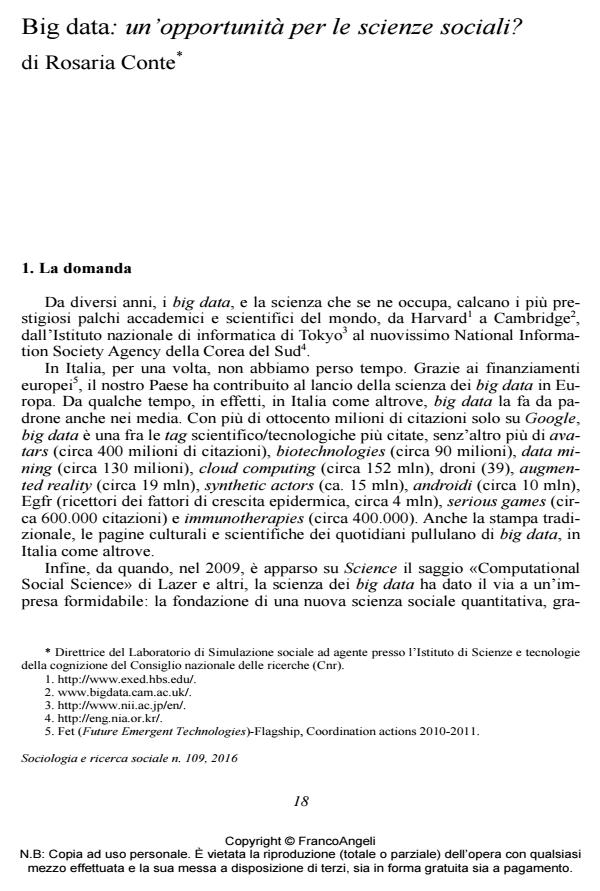Big data: un’opportunità per le scienze sociali?
Titolo Rivista SOCIOLOGIA E RICERCA SOCIALE
Autori/Curatori Rosaria Conte
Anno di pubblicazione 2016 Fascicolo 2016/109
Lingua Italiano Numero pagine 10 P. 18-27 Dimensione file 48 KB
DOI 10.3280/SR2016-109003
Il DOI è il codice a barre della proprietà intellettuale: per saperne di più
clicca qui
Qui sotto puoi vedere in anteprima la prima pagina di questo articolo.
Se questo articolo ti interessa, lo puoi acquistare (e scaricare in formato pdf) seguendo le facili indicazioni per acquistare il download credit. Acquista Download Credits per scaricare questo Articolo in formato PDF

FrancoAngeli è membro della Publishers International Linking Association, Inc (PILA)associazione indipendente e non profit per facilitare (attraverso i servizi tecnologici implementati da CrossRef.org) l’accesso degli studiosi ai contenuti digitali nelle pubblicazioni professionali e scientifiche
In recent years, Big Data and Big Data science are frontstage both in prestigious scientific institutions around the world, and in the media. Italy has contributed to the launch of Big Data science in Europe. With more than eight hundred million quotes on Google, Big Data is one of the most cited technoscientific tags. Furthermore, since 2009, when Lazar and colleagues published the famous «Computational Social Science» on Science, Big Data science gave impulse to a new formidable endeavor: the creation of a new quantitative social science through the extensive application of Big Data science to the study of social phenomena. Now, a few years after the launch of the quantitative science of society, it is time for a first evaluation. Did Big Data maintain its promises? Does it still represent an opportunity for a new science of society? The answer provided in this paper is mildly positive. Big Data represents a good opportunity for the innovation of the social sciences on condition that (a) the application of data science to social data is global, rather than local, and oriented to policy, rather than profit-making; (b) the objective of predicting future events does not inhibit the complementary objective of science, i.e. explanatory speculation; and finally (c) quantitative science does not lead to dispense away with the understanding of the cognitive, social, cultural, and political mechanisms that generate social data
- Types of Big Data and designs of evaluation research Biagio Aragona, in RIV Rassegna Italiana di Valutazione 68/2018 pp.48
DOI: 10.3280/RIV2017-068004 - Data Science and Social Research II Enrica Amaturo, Biagio Aragona, pp.1 (ISBN:978-3-030-51221-7)
- Handbook of Research on Advanced Research Methodologies for a Digital Society Enrica Amaturo, Biagio Aragona, pp.1 (ISBN:9781799884736)
- Per un’epistemologia del digitale: note sull’uso di big data e computazione nella ricerca sociale Enrica Amaturo, Biagio Aragona, in Quaderni di Sociologia /2019 pp.71
DOI: 10.4000/qds.3508 - What People Leave Behind Barbara Sonzogni, pp.293 (ISBN:978-3-031-11755-8)
Rosaria Conte, Big data: un’opportunità per le scienze sociali? in "SOCIOLOGIA E RICERCA SOCIALE " 109/2016, pp 18-27, DOI: 10.3280/SR2016-109003